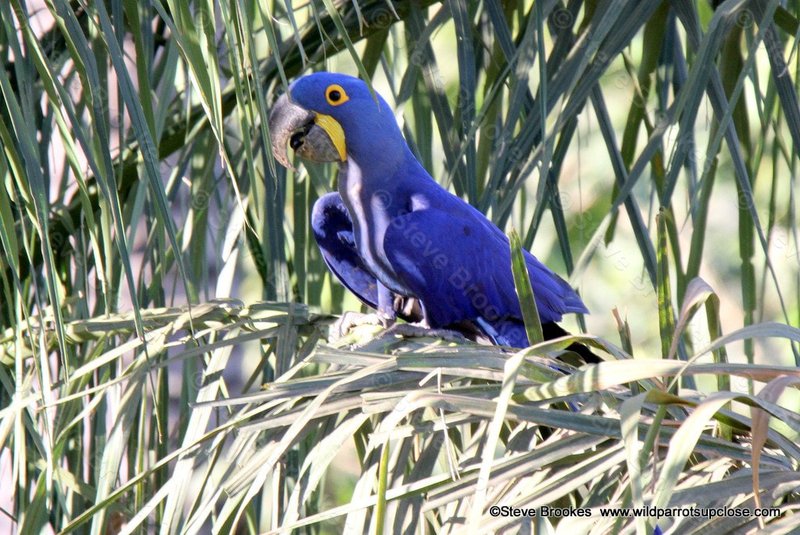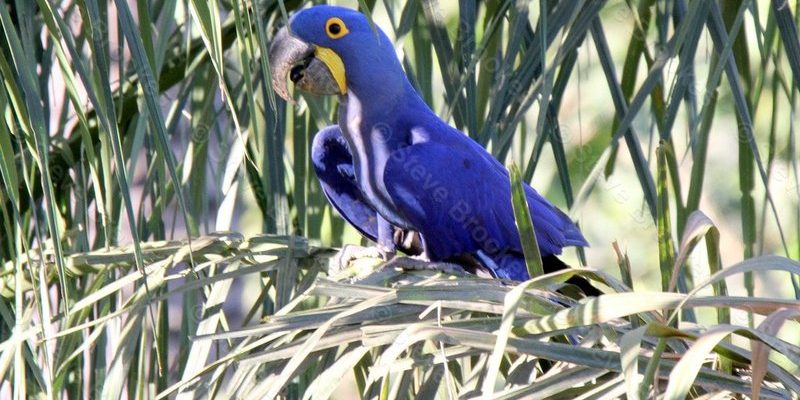
The hyacinth macaw (Anodorhynchus hyacinthinus) is not just known for its beauty; it also has an engaging courtship process that reflects its social nature. These birds are native to the forests of South America and are often seen flying together in pairs or groups, showcasing a remarkable degree of interaction. As we dive into their courtship and mating rituals, we’ll explore how these rituals are as complex and fascinating as the birds themselves.
The Importance of Bonding in Hyacinth Macaws
Bonding is crucial for hyacinth macaws. These birds are monogamous, meaning they usually mate for life. Building a strong connection with a mate involves not just attraction, but mutual trust and understanding. Much like building a friendship, the courtship process for hyacinth macaws emphasizes communication and cooperation.
During courtship, you’ll often see these birds engaging in playful activities. They may engage in gentle preening, where they pick at each other’s feathers, establishing a sense of comfort and intimacy. This behavior is reminiscent of how we might brush off some dirt or lint from a friend’s clothing, a shared moment that strengthens their bond. By grooming each other, they reinforce their relationship and prepare for a deeper commitment.
Additionally, hyacinth macaws use vocalizations to express their feelings. Their calls vary from soft chirps to loud squawks, which can signify excitement or affection. It’s like having a conversation filled with warmth and encouragement, where both partners actively participate in the dialogue. This communication is essential, especially during the mating season when they need to synchronize their activities and intentions.
Courtship Displays and Dancing
One of the most stunning aspects of hyacinth macaw courtship is their elaborate displays. Picture this: a pair of macaws flapping their massive wings, performing a sort of aerial duet that captures the attention of onlookers and potential mates alike. These displays serve multiple purposes, from showcasing their fitness to demonstrating their ability to attract the best partners.
During these performances, male hyacinth macaws often fly in wide circles, showcasing their strength and agility. They may also engage in playful chasing, with one bird pursuing the other in a graceful ballet through the trees. It’s captivating to watch, almost like a scene from a romantic movie where the couple dances under the moonlight, lost in their own world.
Not only do these displays attract mates, but they also help reinforce the bond between partners. When both birds participate in these aerial antics, it fosters a sense of teamwork and unity. Just like a couple practicing a dance routine, they learn to move together seamlessly, building trust and connection within the relationship.
Nesting and the Role of the Female
Once a pair of hyacinth macaws has established a bond, the next step is finding a suitable nesting site. Females are particularly important in this phase. They are the ones who often select the nesting location, which is crucial for the survival of their future chicks. The choice of a nest can impact the overall reproductive success, so it’s a vital decision.
Hyacinth macaws typically nest in tree cavities located high above the ground, giving their young protection from predators. Think of it as a carefully chosen fortress designed to keep their little ones safe. The female inspects potential nesting sites, looking for signs of safety and suitability. This phase gives her the opportunity to exhibit her wisdom and discernment, qualities that make her an attractive partner.
Once a nest is chosen, the female plays a significant role in preparing it. She’ll use saliva, along with materials like wood chips and leaves, to create a cozy environment for their eggs. This nurturing behavior not only helps ensure the safety of the chicks but also reinforces the partnership between her and her mate. It’s a touching reminder of how cooperation in raising a family is essential for many species.
Communication During Mating Season
Communication is key during the mating season for hyacinth macaws. The variety of sounds these birds make is fascinating. Males often increase their vocalizations to impress females, displaying their health and vitality. You might hear them mimicking other bird calls or even creating unique sounds that only their partner recognizes.
This form of communication isn’t just about attracting a mate; it helps both partners stay connected. By vocalizing regularly, they keep tabs on each other, especially when foraging or exploring. It’s much like texting or calling your partner to check in throughout the day. These interactions help solidify their relationship, making it stronger over time.
During courtship, males may also exhibit body language that conveys their intentions. You might see them tilting their heads, flaring their feathers, or even presenting food to their potential mates. These gestures serve as strong signals of affection and commitment. It’s fascinating to watch how much effort they put into ensuring their partner feels valued and loved.
The Role of Mutual Feeding
One of the sweetest rituals in hyacinth macaw courtship is mutual feeding. This behavior involves one partner offering food to the other, often in a show of affection and care. Imagine sharing a favorite snack with a close friend—it’s a moment of connection. For these birds, this act signifies trust and a commitment to nurturing each other.
Mutual feeding usually occurs after they’ve established a bond and continues throughout their relationship. It’s not just about survival; it’s a way for pairs to reaffirm their connection, much like how couples might go out for a meal to celebrate a special occasion. It highlights the importance of sharing resources and taking care of one another during the hard times.
Additionally, sharing food can also play a role in mate selection. A male that offers high-quality food is often deemed more attractive, as it shows he can provide for both himself and his partner. In the wild, where food can be scarce, this behavior can significantly impact their chances of successful reproduction.
Post-Mating Behavior and Raising Chicks
Once the courtship is complete and the eggs are laid, the focus shifts to raising their young. After about 25 to 30 days of incubation, the chicks hatch, and the parenting journey truly begins. Both parents take part in feeding and caring for their young, emphasizing the importance of teamwork.
Hyacinth macaws are known to be attentive parents. They feed their chicks a diet rich in fruits, nuts, and seeds. Much like how we nurture our children, these birds are committed to ensuring their young have the best start in life. The parents work together to protect their nest and teach their chicks essential survival skills.
This post-mating behavior further cements their bond. The shared responsibility of raising chicks strengthens their partnership and ensures the survival of the next generation. It’s a beautiful cycle of love and commitment that continues long after the mating season has ended.
The courtship and mating rituals of the hyacinth macaw are a beautiful tapestry of connection, communication, and cooperation. From their playful displays to the nurturing roles they play as parents, these birds showcase how love and partnership can thrive in the wild. Watching them engage in their courtship is a reminder of the importance of trust and commitment in any relationship.
As we appreciate these magnificent macaws and their unique behaviors, we also gain insight into the larger themes of love and partnership in nature. Whether through mutual feeding or aerial displays, hyacinth macaws teach us that, much like in our own lives, genuine connections are rooted in understanding, care, and a bit of performance. So, the next time you catch a glimpse of these striking birds, know there’s a lot more happening behind those vibrant feathers than meets the eye.

